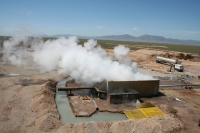When Zeyneb Magavi was renovating her Massachusetts house more than a decade ago, she became excited by the idea of harnessing the ground's constant temperature to power her heating and cooling — a geothermal system.
Her research suggested such a system would be incredibly efficient once up and running, but quotes said it would cost $50,000 to install, which was way out of her budget.
Still, one company offered an intriguing solution, she recalled: "If you convince your neighbors, we'll give you a discount."
Despite her best efforts, none of the neighbors agreed, but it started a process of research and organizing that is close to becoming something bigger.
The nonprofit Magavi co-executive directs, the Home Energy Efficiency Team (HEET), is helping foster two pilot projects in Massachusetts in which gas utilities are creating neighborhood-scale geothermal networks.
"That's pretty stunning — gas utilities building a transition off of gas," she said, noting the pilot projects are using the companies' workforces, know-how, billing processes and more.
In April, the U.S. Department of Energy announced the first-ever backing for 11 community geothermal projects in 10 states, while several states have passed new laws to boost the strategy.
Geothermal is the missing piece in a move to green energy, Magavi said, and as gas infrastructure ages and more localities put in place green goals, the opportunity is vast — and not just for the rich.
"Thermal energy is everywhere," she said. Alongside the electricity grid, "now we need a thermal network."
For the country's first such pilot project in Framingham, Massachusetts, drilling boreholes up to 210 meters deep along a loop over a meter and a half long should wrap up in November, said Eric Bosworth, project manager for Eversource, the gas, electricity and water utility carrying out the work.
"The work itself is very similar to traditional gas work," he said. "We thought it was a good fit for the gas side of the business to explore."
Next year, the loop will start providing heat and cooling for 140 customers, including homes, businesses, public housing, a school and fire department, Bosworth said, which the utility is also fitting with electric heat pumps.
Over the next two years, experts will monitor costs, customer savings on bills and emissions, the effects on the electrical grid and more.
Framingham is proud to partner on the project, Mayor Charlie Sisitsky said in a statement, noting it could more than halve emissions and cut energy consumption for some properties by up to 70%.
The city is currently developing a climate action plan, said Framingham sustainability coordinator Shawn Luz, and "it is clear that innovative, equitable, and comprehensive applications of clean energy technology such as networked geothermal will play a critical role" in achieving net-zero emissions.
'My neighborhood too'
The federal government is already looking to build on the early experiences of communities such as Framingham.
While that pilot was already underway, it received one of the 11 awards to explore how easy it would be to add additional streets to the loop, Bosworth said.
There is already significant consumer interest in such an expansion.
More than 80% of residential customers along the loop wanted to be part of the project, he said, while others were "calling us up and asking, is there any way you can run this down my neighborhood, too?"
The Energy Department said its new funding offer likewise received a strong response — "likely a bellwether of communities seeking more control over their heating and cooling costs and circumstances," Alexis McKittrick, a program manager in the department's Geothermal Technologies Office, said in an email.
"The option to draw secure energy from the heat beneath our feet is available nationwide, and doing so at a community scale could make geothermal district heating and cooling even easier for consumers."
New York state last year mandated that all utilities undertake such a project, in a law that received significant backing from labor unions and green groups. Fourteen such pilot projects are now underway.
Colorado also recently passed a law to boost geothermal, while the 22-member Western Governors Association has launched the Heat Beneath Our Feet campaign to do the same.
Colorado already hosts a pioneering project, in which Colorado Mesa University has since 2008 been building a system that today provides heating and cooling for about two-thirds of the campus, said university president John Marshall.
It is better thought of as a "geo-exchange" system, he said, meaning it is focused on holding a constant temperature and moving around heat and cooling, including using the campus swimming pool and irrigation systems.
The system is made up of miles of water lines running through bore holes hundreds of meters deep, mediated by the constant temperature underground.
"In winter, instead of heating 0-degree water, you're heating 58-degree water. And then in summer, you're taking that 30 excess degrees and dumping it into that water and then sending it underground to cool off," he said.
The university is saving $1.5 million a year in energy costs — and estimates saving another $1 million annually once the system covers the full campus.
"We still don't know precisely how it works," Marshall said of the system. But "it works exceptionally well."
Waste Heat
Other cities are looking at how to use a community-scale thermal strategy without actually tapping ground temperatures.
Duluth, Minnesota, received one of the new Department of Energy grants, with work formally kicking off this month.
The plan aims to use heat produced by a waste-treatment plant located in a low-income neighborhood, where heated water for years has simply been dumped into a river, said Jodi Slick, CEO of Ecolibrium3, a nonprofit co-leading the project.
"The river is frozen in the winter except near the waste-treatment plant, because we're dumping hot water in there," she said.
"We knew we were sitting on all of this waste heat — in a (cold) climate like northern Minnesota, waste heat is kind of ridiculous."
An initial phase of the project will seek to use that waste to heat around 237 buildings, most of which have relied on natural gas.
And there could still be energy left over to extend the system to other parts of the city, Slick said.
"This is about seeing the geothermal as a potential foundational next step for our neighborhood," she said.
"Most people are used to thinking they can't afford these really efficient furnaces. And then you say, 'This could be a community solution.'"






